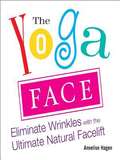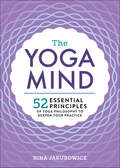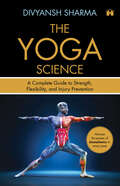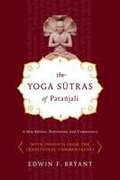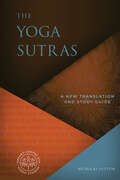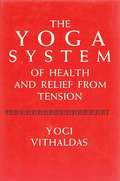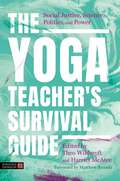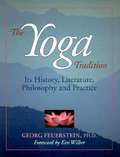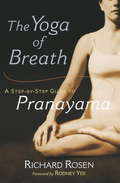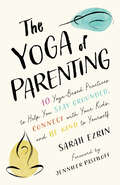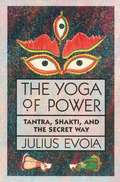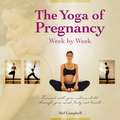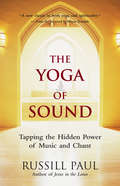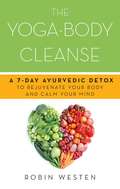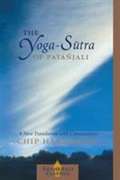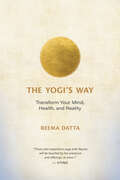- Table View
- List View
The Yoga Face
by Annelise HagenView our feature on Annelise Hagen's The Yoga Face.To keep their faces looking younger, women today try everything from invasive procedures such as plastic surgery and Botox to expensive cosmeceuticals. The Yoga Face is a new and completely natural alternative anti-aging regimen that women can do anytime and anywhere-and in just minutes. The exercises, developed by yoga expert and instructor Annelise Hagen, are based on a simple principle: The muscles of the face are no different from the muscles of the rest of the body. If you don't exercise the muscles below the neck, they become weak and flabby, and the same thing will happen to your face with age. Just as yoga routines work the muscles in the body, the stretches and movements in The Yoga Face tighten and tone the face muscles-and combat wrinkles. "Working out" with fun facial exercises such as the Louis Armstrong "Satchmo," the Marilyn Monroe "kiss," and the "Lion Face," readers will notice changes quickly; and over time, the results are dramatic. Illustrated with more than seventy-five instructive photos throughout, The Yoga Face offers an easy, safe, and effective solution to help women turn back the clock and have beautiful, young-looking skin.
The Yoga Mind: 52 Essential Principles of Yoga Philosophy to Deepen Your Practice
by Rina JakubowiczEnhance your practice and your life with the mindful wisdom of yoga.The profound inspiration that yoga promises begins not in the body, but in the mind. In The Yoga Mind, internationally renowned yoga expert Rina Jakubowicz takes a simple, accessible approach to the complex origins of yoga philosophy. With clear, thoughtful guidance, The Yoga Mind offers everything you need to deepen your yoga practice and discover a meaningful way of life.Your complete resource for bringing yoga philosophy off the mat and into your life, The Yoga Mind includes:Clear explanations of core yoga principles that turn complex theories into memorable lessonsGuided meditations and simple exercises that offer clear, tangible instruction for practicing each principle in your daily lifeA structured approach to vital yoga themes that brings clarity to crucial, but rarely understood, conceptsWhether you read The Yoga Mind cover to cover or skip to a certain topic, you'll find simple actions to incorporate the principles of yoga into a yoga practice that is meaningful to you.
The Yoga Science
by Divyansh SharmaEmbark on a transformative journey through yoga with this comprehensive guide, which beautifully blends ancient wisdom with modern science. Exploring fascinating topics like calorie burn, injury prevention, muscle strength, and bio-individuality, the book reveals how yoga surpasses conventional exercise in functionality and safety. The Yoga Science serves as an invaluable resource for both seasoned practitioners and beginners, enhancing your practice while deepening your appreciation for the timeless wisdom of yoga.Discover the evidence-backed secrets of yoga, with over 50 asanas thoughtfully categorised into 10 distinct types, from foundational to advanced poses. Each asana includes essential details, such as unique attributes, and benefits for various organ systems, targeted areas, and major muscles, along with step-by-step techniques, complete with modifications for all abilities.Rooted in both yogic scriptures and contemporary science, this complete guide offers a fresh perspective on how yoga can empower your body, mind, and soul—tailored to meet your personal needs and goals.What You&’ll Find Inside:• The History of Yoga: Uncover the birthplace of yoga and how it evolved over centuries.• The Meaning of Yoga: More than just stretching! Learn what yoga truly means and its different definitions.• Beginner&’s Guide: Start your yoga journey with the basics—place, equipment, and best practices.• Dimensions of Health: Explore the WHO and yogic perspectives on health.• Alignment & Asanas: Dive into the science of movement and master 50+ asanas with ease.• Biomechanics Breakdown: Learn how your body works through each pose with a fun take on organ systems and joint angles.Plus! A special chapter on tackling common yoga questions and debunking popular myths (no, it won&’t make you taller!).
The Yoga Sutras Of Patañjali: A New Edition, Translation, And Commentary
by Edwin BryantWritten almost two millennia ago, Patañjali's work focuses on how to attain the direct experience and realization of the purusa: the innermost individual self, or soul. As the classical treatise on the Hindu understanding of mind and consciousness and on the technique of meditation, it has exerted immense influence over the religious practices of Hinduism in India and, more recently, in the West. Edwin F. Bryant's translation is clear, direct, and exact. Each sutra is presented as Sanskrit text, transliteration, and precise English translation, and is followed by Bryant's authoritative commentary, which is grounded in the classical understanding of yoga and conveys the meaning and depth of the su-tras in a user-friendly manner for a Western readership without compromising scholarly rigor or traditional authenticity. In addition, Bryant presents insights drawn from the primary traditional commentaries on the sutras written over the last millennium and a half.
The Yoga Sutras for Children
by Roopa PaiWhat are the Yoga Sutras? Instructions for bearded rishis who lived in the forests of ancient India? Or the complete manual of asanas? Neither! In fact, the text may well have been called 'Maharishi P's Ultimate Handbook of Mind Control', for it is really a set of techniques to help us - all of us - awaken and harness the explosive power of our minds, through our actions, our attitudes and our awareness. And not through asanas? That too, but not in the way you imagined it. In this surprising, sparkling book, Roopa Pai unravels the secrets of Patanjali's compact 2,000-year-old text in ways both fun and accessible. Walk down the well-marked paths into a dazzling world where a whole new version of yourself - self-assured, fearless and free - awaits you. Go on, then - what are you waiting for?
The Yoga Sutras of Patanjali
by PatanjaliThe 'Yoga Sūtras of Patañjali' are 196 Indian sūtras (aphorisms) that constitute the foundational text of Ashtanga Yoga, also called Raja Yoga. In medieval times, Ashtanga Yoga was cast as one of the six orthodox āstika schools of Hindu philosophy.
The Yoga Sutras: A New Translation and Study Guide
by Nicholas SuttonThis short course sets out a detailed study of the text, philosophy, and significance of the millennia-old yoga system defined in the Yogasutras. The popular practice of yoga finds its origin in one of the most venerated wisdom books of India: the Yogasutras. Comprised of 196 short statements on the essential teachings of yoga, Patanjali&’s Yogasutras holds the position of being the seminal work that defines the yoga system. Over the centuries many important commentaries have been written that seek to explain and extrapolate the full meaning of the sutras, and to this day, the text continues to be appreciated for the profound wisdom contained within it. While the Yogasutras were originally written in Sanskrit, this short course offers an accessible translation and commentary without sacrificing any of its profound wisdom. This edition will allow the reader to study and dive into the meaning and philosophy of this ancient text with its significant contemporary relevance. Yoga students, practitioners, and scholars alike will appreciate the way in which this short course guides the reader through the text.
The Yoga System of Health and Relief from Tension [Illustrated Edition]
by Yogi VighaldasRichly illustrated throughout with diagrams and pictures.In this book the Yogi Vithaldas outlines the benefits of Yoga for ordinary men and women and explains the system of exercises of which he himself is the teacher. These explanations, illustrated by photographs of the author, describe the movements so clearly that any normally active person can follow them.
The Yoga Teacher Mentor: A Reflective Guide to Holding Spaces, Maintaining Boundaries, and Creating Inclusive Classes
by Jess GlennyHow do we generate enlivening relationships with our students? Create welcoming and inclusive spaces? Navigate common ethical issues? Remain inspired as we encounter the routine challenges of teaching yoga day-to-day? Full of practical information for new teachers, this book is also much more than a beginner's guide, considering questions that continue to arise through the course of a teaching life.With reflective and experiential exercises throughout, the book is designed to create different lenses through which teachers of all stripes and vintages can view difficult situations and amplify their understanding of what it means to hold rich and meaningful classes. The intention is to invite self-reflection and offer possibilities, without being prescriptive. Emphasising the need for yoga teachers to know about more than alignment and sequencing, The Yoga Teacher Mentor accompanies the reader through the rich, complex and rewarding process of teaching yoga.
The Yoga Teacher's Survival Guide: Social Justice, Science, Politics, and Power
by Theo Wildcroft Harriet McAteeThis is a yoga book with a difference. In this guide, the authors embark on a ground-breaking exploration of the multifaceted challenges faced by yoga teachers in today's complex world. Drawing upon their experience in training yoga teachers, Theo Wildcroft and Harriet McAtee have compiled a collection of wisdom from some of the best-known and respected yoga teachers worldwide, including Peter Blackaby, Donna Farhi, Jivana Heyman, and Jules Mitchell. Through this collaboration, these experts address six key themes that resonate deeply within the yoga teaching community: critical thinking, honouring our sources, scientific enquiries, trauma, race and equity, and money and power. This book will teach yoga teachers what they need to know about honouring yoga's sources and surviving and thriving in the modern yoga industry.
The Yoga Tradition: Its History, Literature, Philosophy and Practice
by Georg FeuersteinThe author is founder-director of the Yoga Research Center in Northern California and the author of 30 books on yoga. The present volume is a revised and greatly enlarged edition of the author's 1989 work, Yoga: The Technology of Ecstasy .
The Yoga of Breath: A Step-by-Step Guide to Pranayama
by Richard Rosen Rodney YeeFor several thousand years, yogis have drawn on the powerful practice of pranayama, a technique of controlling the breath to maximize prana or life energy. Pranayama has been practiced to rejuvenate the body and as a means of self-study and self-transformation. While most yoga practitioners today focus on asanas, or body postures, a growing number of people are learning the complementary practice of pranayama to deepen and enrich their practice. The Yoga of Breath is a guide to learning the fundamentals of pranayama and incorporating them into an existing yoga practice. Rosen's approach is easy to follow with step-by-step descriptions of breath and body awareness exercises accompanied by clear illustrations. The book also covers the history and philosophy of pranayama, offers useful practice tips, and teaches readers how to use props to enhance the exercises.
The Yoga of Herbs: An Ayurvedic Guide to Herbal Medicine (Second Revised & Enlarged Edition)
by David Frawley Vasant LadFor the first time, here is a detailed explanation and classification of herbs, using the ancient system of Ayurveda. More than 270 herbs are listed, with 108 herbs explained in detail. Included are many of the most commonly used western herbs with a profound Ayurvedic perspective. Important Chinese and special Ayurvedic herbs are introduced. Beautiful diagrams and charts, as well as detailed glossaries, appendices and index are included.
The Yoga of Parenting: Ten Yoga-Based Practices to Help You Stay Grounded, Connect with Your Kids, and Be Kind to Yourself
by Sarah EzrinBring the wisdom of yoga into your parenting journey. Mom and yoga teacher Sarah Ezrin offers 34 practices to find more presence, patience, and acceptance—with your child and with yourself.&“I can say without a doubt that the most advanced yoga I&’ve ever done is raising a child,&” writes Sarah Ezrin. While many people think of yoga as poses on a mat, The Yoga of Parenting supports people in bringing the spiritual principles of yoga into their lives—particularly their families. Ezrin, a longtime yoga teacher, supports readers and practitioners in slowing down, becoming present with our children and ourselves, and acting with more compassion. Each chapter highlights a yogic posture and theme and explores how it relates to parenting, including presence, boundaries, balance, and nonattachment. Chapters include prompts such as intention setting, breathwork, and journaling. Ezrin also features the stories and insights of a wide range of yoga practitioner parents whose experiences include single parenting, grandparenting, and passing on intergenerational yoga traditions. In addition to the opening posture, each chapter includes: &“Breath Breaks&” invitations to mindfully breathe. &“On the Mat&” practices to show us how we can apply the lessons on our yoga mat in a more general sense. &“Parenting in Practice&” offering and advice from parents in the US and abroad. &“Off the Mat and Into the Family&” fun exercises to help us bring the work off the mat and into our homes. Practicing yoga can help us become kinder to ourselves, more aware of our thoughts and actions, and more present in our lives. What more important sphere to want to become kinder, more aware, and more present than with our families?
The Yoga of Power: Tantra, Shakti, and the Secret Way
by Julius EvolaDrawing from original texts on self-mastery, Evola discusses two Hindu movements--Tantrism and Shaktism--which emphasize a path of action to gain power over energies latent within the body.
The Yoga of Pregnancy Week by Week
by Mel CampbellFocusing on creating a conscious union with the growing baby in utero, this detailed guide introduces a practice of weekly meditations, yoga, and affirmations that reflect the developmental and physiological changes taking place both inside and outside the womb. The book enhances the experience of pregnancy and prepares mothers physically, emotionally, and spiritually for child birth and motherhood. Beginners to yoga as well as regular practitioners will learn unique approaches and proper techniques that initiate a healthful, purposeful connection with the mother's own body and with her unborn child.
The Yoga of Sound: Tapping the Hidden Power of Music and Chant
by Russill PaulFor thousands of years Hindu spirituality has understood the profound effect that sound has on our well-being. From this tradition comes The Yoga of Sound, which draws on yoga's long history of applying sound to reduce stress, maintain health, and invoke spiritual awakenings. In lucid exercises presented both in the book and on accompanying downloadable audio tracks, Russill Paul shows how everyone can learn the art of mantra and how these practices can help to optimize the flow of energy within the body and enhance emotional well-being.
The Yoga-Body Cleanse: A 7-Day Ayurvedic Detox to Rejuvenate Your Body and Calm Your Mind
by Robin WestenENHANCE YOUR PRACTICE Yoga brings us into balance by opening the heart, clearing the mind and increasing flexibility while strengthening muscles, bones and internal organs. These amazing benefits are boosted to the max in The Yoga-Body Cleanse, which uses traditional Ayurvedic principles to rid your body of toxins and leave you fully rejuvenated. The simple day-by-day program in this book offers a complete diet of smart, delicious foods with super-healing powers that strengthen you instead of leaving you hungry. By following this holistic program you will: • Feel Energized • Flush Contaminants • Lose 5 to 8 Pounds • Relieve Stress • Look Younger • Increase Mental Clarity
The Yoga-Sutra of Patanjali: A New Translation with Commentary
by Chip HartranftIn just 196 short aphorisms, this classic work of Indian philosophy spells out succinctly how the mind works, and how it is possible to use the mind to attain liberation. Compiled in the second or third century CE, the Yoga-Sutra is a road map of human consciousness--and a particularly helpful guide to the mind states one encounters in meditation, yoga, and other spiritual practices. It expresses the truths of the human condition with great eloquence: how we know what we know, why we suffer, and how we can discover the way out of suffering. Chip Hartranft's fresh translation and extensive, lucid commentary bring the text beautifully to life. He also provides useful auxiliary materials, including an afterword on the legacy of the Yoga-Sutra and its relevance for us today.
The Yoga-sutra of Patañjali: A New Translation with Commentary
by Chip Hartranft PatañjaliIn just 196 short aphorisms, this classic work of Indian philosophy spells out succinctly how the mind works, and how it is possible to use the mind to attain liberation. Compiled in the second or third century CE, the Yoga-Sutra is a road map of human consciousness--and a particularly helpful guide to the mind states one encounters in meditation, yoga, and other spiritual practices. It expresses the truths of the human condition with great eloquence: how we know what we know, why we suffer, and how we can discover the way out of suffering. Chip Hartranft's fresh translation and extensive, lucid commentary bring the text beautifully to life. He also provides useful auxiliary materials, including an afterword on the legacy of the Yoga-Sutra and its relevance for us today.
The YogaFit Athlete: Up Your Game with Sport-Specific Poses to Build Strength, Flexibility, and Balance
by Beth ShawBring the strength and breathing power of yoga to the sports you love--and seriously up your game!Yoga routines designed specifically for swimming, running, cycling, golf, tennis, baseball, football, volleyball, basketball, skiing, snowboarding, weight lifting, kickboxing, boxing, CrossFit, and more! "Your body can either help you achieve your goals or get in the way of you living your best life. By practicing yoga and meditation, you can make your body work with you, not against you."--Beth Shaw Whether you're a professional athlete, a weekend warrior, or a pick-up game enthusiast, yoga can dramatically affect your athletic performance and improve your alignment, balance, core stability, strength, flexibility, agility, endurance, lung capacity, and mobility. In this motivating and practical guide, celebrated fitness expert Beth Shaw provides short, sport-specific yoga routines designed to help counter tight muscles, overuse injuries, and musculature imbalances. By adding a quick yoga routine to any workout, you will increase your overall strength and health, and achieve your personal best. Inside you'll find * fully illustrated, sport-specific yoga routines that engage the core, enhance your play, and reduce the risk of injury * essential warm-up and cool-down movements to complement any athletic endeavor * simple breathing exercises to steady your breath and calm your nerves during competition * meditation techniques to help clear your mind and bring laser focus to your goals * guided imagery and visualization exercises to improve performance * strategies for coaching yourself and othersFrom the Trade Paperback edition.
The Yogasūtra of Patañjali: A New Introduction to the Buddhist Roots of the Yoga System
by Pradeep P. GokhaleThis book offers a systematic and radical introduction to the Buddhist roots of Pātañjala-yoga, or the Yoga system of Patañjali. By examining each of 195 aphorisms (sūtras) of the Yogasūtra and discussing the Yogabhāṣya, it shows that traditional and popular views on Pātañjala-yoga obscure its true nature. The book argues that Patañjali’s Yoga contains elements rooted in both orthodox and heterodox philosophical traditions, including Sāṅkhya, Jaina and Buddhist thought. With a fresh translation and a detailed commentary on the Yogasūtra, the author unearths how several of the terms, concepts and doctrines in Patañjali’s Yoga can be traced to Buddhism, particularly the Abhidharma Buddhism of Vasubandhu and the early Yogācāra of Asaṅga. The work presents the Yogasūtra of Patañjali as a synthesis of two perspectives: the metaphysical perspective of Sāṅkhya and the empirical–psychological perspective of Buddhism. Based on a holistic understanding of Yoga, the study explores key themes of the text, such as meditative absorption, means, supernormal powers, isolation, Buddhist conceptions of meditation and the interplay between Sāṅkhya and Buddhist approaches to suffering and emancipation. It further highlights several new findings and clarifications on textual interpretation and discrepancies. An important intervention in Indian and Buddhist philosophy, this book opens up a new way of looking at the Yoga of Patañjali in the light of Buddhism beyond standard approaches and will greatly interest scholars and researchers of Buddhist studies, Yoga studies, Indian philosophy, philosophy in general, literature, religion and comparative studies, Indian and South Asian Studies and the history of ideas.
The Yogi Assignment: A 30-Day Program for Bringing Yoga Practice and Wisdom to Your Everyday Life
by Kino MacgregorAn inspirational 30-day yoga and lifestyle program that will challenge your mind, body, and spirit--by one of the most dynamic and high-profile contemporary Ashtanga yoga teachers, Kino MacGregor.“The brave heart of a yogi is defined by actions that make the world a better place.”Live with authenticity, practice patience, let go of negativity—these are some of the core tenets of a yoga lifestyle, on and off the mat. Yoga is about much more than twisting yourself into shapes—the heart of this ancient practice is an inner journey, one of reflection, spiritual awakening, and ultimately a calm, clear mind. The Yogi Assignment is a 30-day introduction to these life-affirming and simple, yet revolutionary, principles. Led by master teacher Kino MacGregor, this journey will challenge and uplift your body, mind, and spirit. Each day offers a practice and meditation that will help you confront your emotional, physical, and mental limitations and inspire real change in your life. MacGregor is a fierce, loving guide who encourages you to look deeply within to find your wellspring of inner strength and courage.
The Yogi Code: Seven Universal Laws of Infinite Success
by Yogi Cameron“Readers seeking more general spiritual advice for life will appreciate these lucid teachings from a compassionate teacher.” —Publishers Weekly Thousands of years of Yogic wisdom distilled into a code of seven daily practices…While most of us think of yoga as a series of poses, the path of a Yogi goes far beyond the mat into a set of daily practices that can reverse aging, grant better health and confidence, help you create deeper connections, and ultimately allow you to live your true purpose. The knowledge and techniques of The Yogi Code can unleash your power to manifest your full potential, every day. In this succinct yet illuminating book, Yogi Cameron demystifies seven thousand years of ancient wisdom into accessible language, regardless of your familiarity or ability with yoga. You’ll learn to balance daily demands while achieving a higher level of consciousness and self-knowledge. Your new routines will build a strong foundation for centering yourself and being guided by your intuition, ultimately leading you to gain mastery over your fears and to achieve your highest goals. With carefully crafted chapters and practices expertly created to fit into your fast-paced days, The Yogi Code will point the way to your eternal purpose.
The Yogi’s Way: Transform Your Mind, Health, and Reality
by Reema DattaFIND PEACE, CREATIVITY, VITALITY, AND PURPOSE Celebrated yogi Reema Datta presents her world-renowned twelve-week course in book form — an accessible and practical method for cultivating mental and emotional well-being, physical health, and spiritual nourishment. She combines ancient yogic wisdom and practices with cutting-edge science and personal stories to offer insightful solutions to the challenges of modern life. Her holistic program integrates movement and breathwork with visualization, meditation, and awareness practices. The Yogi’s Way will help you overcome challenging thoughts and emotions such as fear and anxiety, awaken your creative potential, and connect with consciousness — the deepest and most powerful part of yourself.
